How to connect the pumping station to the well correctly:
Connecting the pumping station to the well is a necessary final stage in the implementation of water supply at home.
It requires the implementation of some rules and features, which will be discussed in this article.
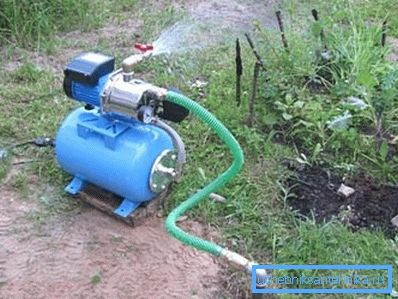
General provisions
The water supply system, organized by yourself with the help of the water supplying station, must meet all the needs of the residents.
By the number of functions performed, the equipment in question may be industrial or domestic. For our case is quite suitable household option.
Here is the optimal set of requirements for home plumbing requirements:
- Providing clean potable water.
- The implementation of watering crops.
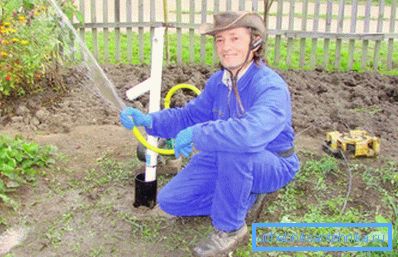
- Satisfaction of the entire household unit, which includes a toilet, bath or shower, washing machine, dishwasher.
- The flow of water into the heating system of the building.
When choosing equipment, you should also know that there are both automatic models and manual switching.
Connection
Before you connect the pumping station to the well, you need to decide where it will be located.
Installation location
Two options are possible:
- Basement. Particularly noteworthy advantages of this location is the ability to quickly and permanently access equipment. The room should be heated to prevent freezing of water. The station itself is placed on a special pallet or hill to protect against a possible rise of groundwater. The price of the implementation of this method is cheaper, since it is not used already ready storage.

Advice: it is not recommended to install the equipment against the walls of the basement. Because it vibrates during operation and can beat the body.
- A caisson is a dug below the level of soil freezing and is necessarily a warmed pit directly above the squash mine. In this case, the pumping station is installed in the well. Such an arrangement of equipment is suitable if there is no basement in the house or unwillingness to occupy it.
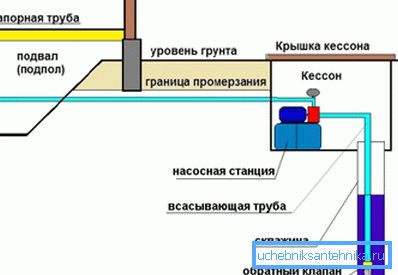
Installation
Now consider how to install a pumping station on the well. For example, take the two-pipe model with an ejector.
Tip: if the depth of the mine does not exceed ten meters, then the one-pipe type of station is quite suitable. This will allow you to save significant financial costs.
Instruction:

- First we collect the ejector, which is a solid cast-iron node with three outlets.

- In the lower part of it we mount the filter from a fine mesh.
- In the upper sector we put the necessary sizes on the plastic socket.
- At the outlet of the sgon install a bronze clutch for the transition to a plastic pipe.
- With tow or fum-tapes we guarantee tightness of the joints.
- We dig a trench to a depth below the level of soil freezing.
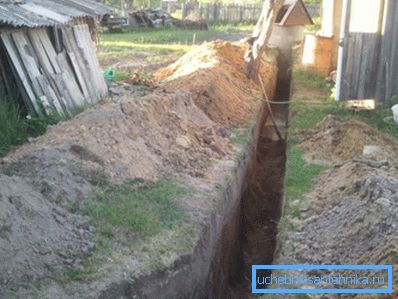
- We install in it the water pipeline. In this case, the length of the pipe should be chosen with a margin.
Tip: it is recommended to additionally heat all elements of the well located underground. This will prevent water from freezing in case of severe frosts.
- With the help of the coupling, we attach one edge of the casing tube to the ejector.
- The second end is passed through a rectangular knee. Fill the empty space with foam.
- The pipe is connected to the corner transition element, which is fixed on the outer part of the water supply system.
- The ejector assembled in one piece is lowered into the well.

- Fill the trench with earth. The assembly of the pumping station at the well pump is completed.
Frequently made mistakes
When installing all components of plumbing equipment a number of common mistakes are possible, knowledge of which will help you to avoid them:
- Low supply of used pipe lengths. Often, the presence of angles and the thickness of the foundation, which increase the distance laid, are not relevant. Be careful. It is better to overpay for the extra length that can be reduced, than to wonder about increasing the product and losing large sums for hermetic adapters.
- Twisting threaded fasteners with bare hands. At the moment of twisting it may seem that the detail of the village is tight, but it may leak during operation. Be sure to use the key to ensure complete tightness.

- Negligence in relation to the hydroaccumulator. Be sure to check the internal pressure in it. If it falls below 1.2 atmospheres, then it must be increased using a compressor or pump for cars.
Filter
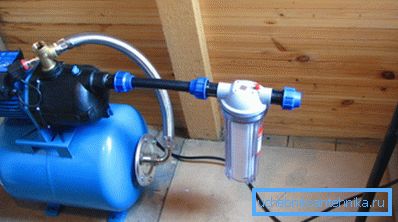
Any water carries a lot of impurities in the form of sand, clay and other heavy elements. They are sufficiently harmful for the internal structure of the equipment, so that with a large accumulation it can be put out of action. Therefore, if you want to extend the life of the station, it requires installation.
But at the same time it is necessary to remember about the negative effect: a decrease in the force of the water inflow. To prevent this trouble, it will be enough to regularly clean contaminated filter elements. The main thing - to prevent complete clogging of the system, which will certainly lead to a breakdown of the device.
Conclusion
Even if the drilling process is successfully completed, you should not relax. After all, now it is required to provide the whole house with water extracted by such labor. A household water supply station from a well, which can be easily installed with its own hands, will perfectly cope with this.
It should be understood exactly what you need this equipment to choose the right volume and power. It takes into account the need for watering the garden, the full functioning of washing and dishwashers, the supply of drinking water and the implementation of the bathroom.
Installation is possible in the basement or in the caisson. This primarily depends on the degree of development of your site. Buy pipes with a margin, and make all threaded connections with a key, without overestimating the strength of your hands.
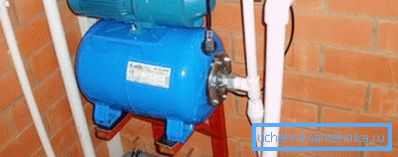
The video in this article will introduce you to additional information regarding this topic. Successful to you installation works!